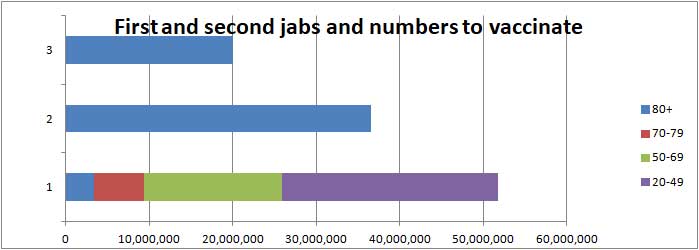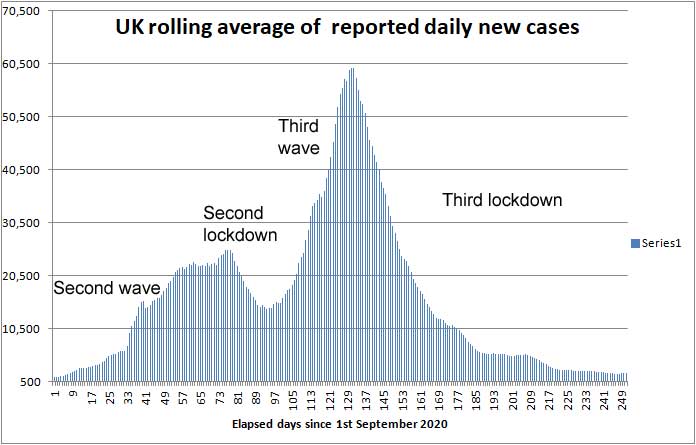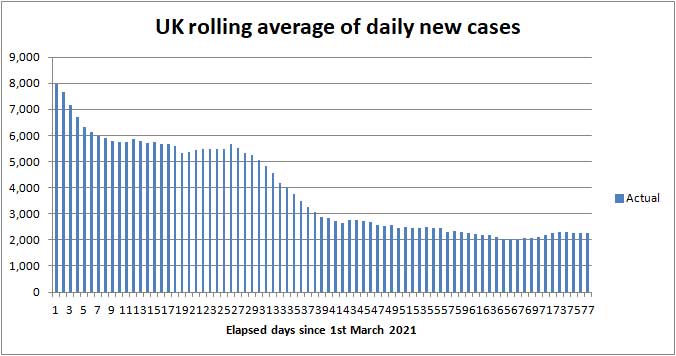
Angus and Rosemary's Miscellany
of Malvern - Other Resources
|
Coronavirus (COVID-19) epidemic weekly update for Malvern Seniors17th May 2021 COVID LOCKDOWN in ENGLAND EXIT STEP 3, DAILY CASES CREEPING UP Risk remains low within the Malvern Hills district Skip to menu of archived pages PreambleWe keep an eye on the published government figures and monitor the media to asses the level of risk for Seniors in the Malvern Hills district. This page is currently updated every Sunday between 1800 and 2400 hours GMT. Information about Coronavirus can be found on the NHS website: https://www.nhs.uk/coronavirus
|
| Districts of Worcs | Cases | Weekly increase | Population |
| Bromsgrove | 6,259 | +8 | 98,529 |
| Malvern Hills | 2,797 | +14 | 77,545 |
| Redditch | 6,236 | +12 | 85,317 |
| Worcester | 6,110 | +29 | 103,542 |
| Wychavon | 6,442 | +11 | 126,240 |
| Wyre Forest | 5,580 | +13 | 100,957 |
| TOTAL | 33,511 | +87 | 592,130 |
| COMPARE WITH | |||
| County of Hereford | 7,129 | +40 | 195,000 |
| Leicester (city of) | 37,076 | +186 | 400,000 |
Cumulative cases reported by PHE in Worcestershire to 16th May 2021
Cases are a little higher in Worcestershire and Leicester this week, and slightly lower in Herefordshire.
Interactive map
At the bottom of the Coronavirus Dashboard (daily update) page there is an Interactive Map which is coloured to show the variation in infection rate across the country.
Click for Interactive Map of COVID cases
Note: the Interactive Map works on desktop PCs but it's possible you may encounter difficulties using a tablet or smartphone.
New cases in Malvern are currently too low to register on the map, except for Pickersleigh where 3 cases were reported in week ending 11th May. Five cases have been reported in the Ronkswood and Nunnery Wood district of Worcester.
Number of deaths
Statistics on COVID deaths are published by Public Health England, The Office of National Statistics, and NHS England.
PHE figures
Public Health England reports that the cumulative total of COVID (28) deaths in UK hospitals and care homes has risen by 74 in the last week to 127,679 while the daily average has flat-lined at 10 deaths per day.
Click to view the UK government Coronavirus Dashboard
In comparison averaged over recent years 1,700 people die daily from all causes so COVID-190 deaths are now less than 1%.
ONS figures
The Office of National Statistics (ONS) separately reports registered deaths in England and Wales where COVID-19 is mentioned on the death certificate. The ONS figures lag the PHE figures by 10 - 14 days and do not include Northern Ireland and Scotland.
The ONS figures are broken down by District providing a glimpse of where deaths are occurring. The provisional cumulative total of COVID related deaths in Worcestershire reported by the ONS up to 30th April 2021 (week 17 of 2021) is shown below.
Note: the numbers are from the ONS Death Registrations-Pivot table
| Districts of Worcs | Deaths 2020 |
Deaths 2021 |
Week 17 | Population |
| Bromsgrove | 164 | 101 | 0 | 98,529 |
| Malvern Hills | 61 | 83 | 0 | 77,545 |
| Redditch | 108 | 84 | 0 | 85,317 |
| Worcester | 87 | 114 | 0 | 103,542 |
| Wychavon | 157 | 118 | 0 | 126,240 |
| Wyre Forest | 171 | 104 | 0 | 100,957 |
| TOTAL | 748 | 604 | 0 | 592,130 |
Provisional cumulative COVID-19 deaths registered by ONS to 30th April 2021
Happily, in the last week, no COVID-19 deaths were reported by the ONS in Worcestershire.
In England and Wales 205 COVID-19 related deaths were reported by the ONS in the week to 30th April; 53 lower than the week before, a fall of 20%. Of these 30 were in a care home, 36 at home, 1 in a hospice, 133 in hospital and 5 elsewhere.
The provisional COVID-19 death toll for all weeks of the epidemic is shown in the following table for England and Wales.
| Year | Provisional COVID-19 UK death toll in England and Wales |
| 2020 | 80,741 |
| 2021 | 56,951 |
| TOTAL | 137,692 |
COVID-19 death toll in England and Wales to 30th April 2021 (source: ONS)
Note: summation of rows 9-344 of ONS Registrations-Pivot Table spreadsheet tab.
The UK death toll is about 10% higher as deaths for Scotland and Northern Ireland have to be added.
Click for national ONS data on deaths (Excel spreadsheet)
The death toll based on death certificates is about 20% higher than deaths within 28 days reported by PHE.
NHS England figures
The table below shows latest COVID deaths in Worcestershire hospitals reported by NHS England to 14th May.
| Worcestershire | Cumulative deaths | Weekly increase |
| Acute hospitals | 806 | 0 |
| Care hospitals | 63 | 0 |
| TOTAL | 869 | 0 |
Click for NHS COVID-19 Daily Deaths
The main point to note is the COVID death rate has fallen far from its peak and there are now very few if any weekly deaths in Worcestershire.
Healthcare numbers
The UK government Coronavirus Dashboard includes important information about healthcare statistics.
| Hospital cases (UK) | Number | Weekly change |
| Patients currently in hospital | 991 | -161 |
| Patients on ventilation | 129 | -34 |
| Patients admitted daily | 103 | +2 |
Headline summary of patients in hospital as reported 16th May 2021
The number of COVID-19 patients currently in hospital is now down to 2% of the peak and the number of patients on ventilators continues to fall slowly.
In the past, the steady state number of COVID patients in hospital has been roughly ten time the number of patients admitted daily, suggesting the number of COVID patients in hospital could plateau at about 1,000.
Last year roughly 10% of new cases were admitted to hospital and of those at least 1 in 5 died.
The latest figures suggest about 5% of new cases are being admitted to hospital. If it is assumed that due to vaccination just 1 in 10 of these now dies then 103 hospital admissions per day may suggest up to 10 UK deaths per day in early June.
Note: these ratios are very rough and ready and should change as more of the population is vaccinated.
Tabulated figures for bed occupancy in Worcestershire Acute and Care hospitals can be found on the NHS England website.
Click for NHS England COVID-19 Hospital bed Activity
You can also obtain a snapshot of bed occupancy from the Coronavirus Dashboard daily update page, by entering your postcode at the bottom of the page, which will show data for Worcestershire; then find and click All Health Data to see bed occupancy. This information has returned to the Worcestershire Coronavirus Dashboard.
Click to view Worcestershire Coronavirus Dashboard.
Recently there have been 8 COVID patients in Worcestershire Acute Hospitals of which none were on ventilators; up from 5 last week.
The main point to note is that the number of Worcestershire COVID-19 beds occupied is still much lower than the peak of 300 beds..
Forecast for the week ahead
Trends suggest that during the next seven days (up to 23rd May) the cumulative total of new UK COVID-19 cases reported by PHE on the Coronavirus Dashboard could increase by about 16,500 towards 4,467,500.
In Worcestershire there could be 100 new cases of COVID-19, and possibly up to 20 cases in the Malvern Hills district.
We estimate the number of COVID (28) deaths will increase by about 70 nationally towards 127,750 during the 7 days ending 23rd May 2021.
In the county of Worcestershire, assuming a 0.5% death rate, the 87 new cases this week should translate to no more than one COVID death per fortnight in early June.
Longer term forecast
Commentators suggest that the UK is approaching herd immunity due to both the success of the vaccination programme, and immunity of those who have already been infected by COVID-19.
The flare up in Bolton casts some doubt on this, so we will have to wait and see what happens in coming weeks. Matt Hancock says most of those in hospital in Bolton had been offered the vaccine and had not taken it. Reports from Oxford are suggesting the current vaccines prevent serious illness from 'new variants' while pundits warn against letting new cases 'rip' as the virus will weed out the frail and unvaccinated.
The message is therefore to continue to be reasonably cautious and get vaccinated.
It is anticipated infections will continue at a low level with occasional localised flare ups such as in Bolton and Blackburn. As many of those aged under 40 years have still to be vaccinated caution should be exercised until the end of June.
There is a potential threat from foreign 'new variants of concern' against which the present vaccines may prove less effective but don't worry as scientists are already working on booster jabs to guard against that threat.
We and scientists will have to wait 3 or 4 weeks to ascertain whether or not the outbreak of the Indian variant of COVID-19 is any worse than the Kent variant currently circulating, and whether it can be contained by a combination of surge testing, isolating the sick, and mass vaccination. In the worst case, exit from lockdown on the 21st June may have to be delayed in some districts.
Advice for Seniors
 The
daily number of new cases of Coronavirus has fallen a long way from
the peak so we judge the risk to be LOW for most Seniors
in the Malvern Hills district who have been vaccinated more than 3 weeks ago;
see our annex and riskometer opposite.
The
daily number of new cases of Coronavirus has fallen a long way from
the peak so we judge the risk to be LOW for most Seniors
in the Malvern Hills district who have been vaccinated more than 3 weeks ago;
see our annex and riskometer opposite.
But remember, if you are elderly, have not been vaccinated, and were to catch COVID there is a significant chance that you will either die or your long term health may be seriously damaged, so get your vaccine and continue to take care of yourself and those you love. 90% of COVID deaths are in those aged over 60 years according to NHS England statistics.
Click for our risk of death table (for those who have not been vaccinated)
It's possible, despite a second jab, for some Seniors to become ill with COVID, though for most this is likely to be a mild illness.
The simple safeguards to remember are to:
-
wash your HANDS thoroughly, using soap and hot water, for 20 seconds, including after handling deliveries to your home, to kill virus picked up from contaminated surfaces see note 1;
-
wear a FACE mask when unavoidably near other people for example when shopping, visiting hospital or the chemist, and using public transport;
-
SPACE at least 2 metres from people outside your bubble see note 2;
-
preferably meet friends and other households outdoors in the FRESH AIR, else keep the windows open if you are indoors;
-
minimise TIME near strangers;
-
self-isolate and book a test if you have COVID-19 symptoms (new continuous cough, fever or loss of, or change in, sense of smell or taste).
Hence the PMs mantra:-
HANDS, FACE, SPACE, FRESH AIR
We are now moving from a regime where the government tells us what to do to one where it is up to us to take personal responsibility for assessing the risk to ourselves and our loved ones.
Remember, if you have symptoms of COVID-19 at home and can't count from one to ten out loud due to shortness of breath, you should immediately call your GP, 111 or 999 for advice.
Click for UK government Coronavirus guidance on what you can and cannot do
Notes:
1) Wash your hands thoroughly before touching your face to avoid transferring virus from contaminated surfaces to your mouth, eyes and nose. If outdoors use hand gel.
2) Two metres is further than you think - roughly an arm and a walking stick away.
3) If possible keep windows and doors open to improve ventilation when meeting others.
4) If you have been vaccinated and are infected by COVID-19 you may not get the classic symptoms; you could for example have no symptoms or feel like you have a common cold. If in doubt get a test.
Japanese advice has been to avoid the three Cs, see poster below:
-
Crowded spaces with poor ventilation
-
Crowded places with many people nearby
-
Close-contact settings such as close range conversations
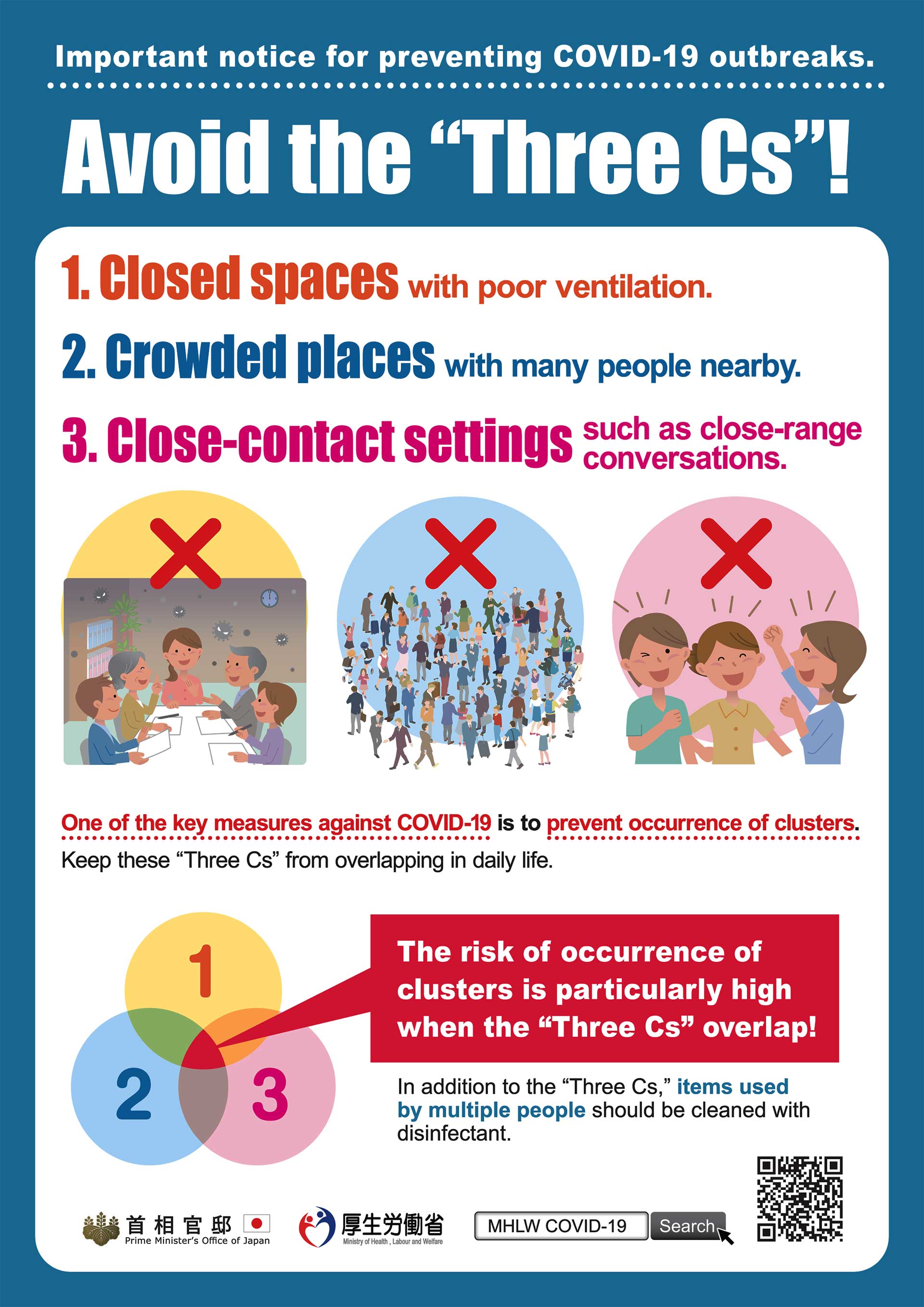
COVID advice in Japan
Most of us who have received two jabs probably now feel safe mingling with friends and family.
Annex to 16th May update
Commentary
The COVID alert level has been lowered from 4 to 3 meaning the virus is in general circulation, but not at a high level.
Click for BBC explainer about alert levels
The Prime Minister held a press conference on Monday announcing that England would move to STEP 3 of the exit from lockdown on 17th May.
Click for press release on further easing of COVID restrictions on 17 May
To quote:
From Monday 17 May indoor hospitality can reopen and indoor entertainment can resume, including cinemas, museums, and children’s play areas.
Up to 6 people or 2 households will be able to meet indoors and up to 30 people outdoors.
All remaining outdoor entertainment can reopen, such as outdoor cinemas and performances.
Some larger events will be able to take place, including conferences, theatre and concert performances, and sports events. Restrictions on the number of attendees will remain as set out in the Roadmap.
Guidance on meeting family and friends will be updated.
The public can make informed, personal decisions on close contact, such as hugging, with their friends and family. Close contact continues to carry a risk of catching or spreading COVID-19, and people must consider the risk to themselves and to others.
COVID-secure rules remain for the workplace and businesses, such as in shops and hospitality.
Face coverings will no longer be needed in classrooms or for students in communal areas in secondary schools and colleges.
Twice weekly home testing will remain to control infection rates.
All remaining university students will be eligible to return to in-person teaching and learning from May 17, and should get tested twice a week upon return.
Up to 30 people will now be able to attend weddings, receptions, and commemorative events including wakes, as well as standalone life-cycle events. These can take place outdoors or at any indoor COVID secure venue that is permitted to open.
The number of people able to attend a funeral will be determined by the number that can be safely accommodated in the venue with social distancing in place.
30 people will be able to attend a support group or parent and child group. The limit will not apply to children under 5.
Organised adult sport and exercise classes can resume indoors and saunas and steam rooms may reopen. Care homes residents will be able to have up to five named visitors, with two visitors able to attend at once provided they are tested and follow infection control measures. Residents will also have greater freedoms to leave their home without having to isolate on their return.
On Wednesday there were reports of outbreaks of the Indian variant of COVID-19 in Bolton, Blackburn with Darwen, and London. Scientists anticipate cases may be scattered throughout the country and in time the Indian variant could become dominant.
Click for BBC report on hotspot areas
On Thursday it was reported a few cases of the south African variant had been found in Redditch.
Click for BBC report on Redditch situation
On Friday the PM held a press conference to update the public on the Indian variant. It is spreading more quickly than the Kent variant, but it is not yet clear by how much or whether mortality will be different. Nevertheless STEP 3 out of lockdown will go head on 17th May as planned and the situation will be monitored closely.
Click for PM statement at coronavirus press conference on 14 May
Those aged 38+ can now get jabs and the time between first and second jabs for those aged 50+ is being reduced from 12 to 8 weeks.
Professor Tim Spector (of the Zoe Symptom Study app) reports infection by COVID-19 amongst those who have been vaccinated is mostly a mild illness - his team will publish a report next week.
Click to view Prof Tim Spector's weekly update on Youtube
Overseas travel
The Transport Secretary has confirmed that international travel can begin to safely reopen from 17 May, allowing people to go on foreign holidays to 'green' list countries accepting visitors. However don't get too excited as few popular resorts are on the green list. Israel is currently a 'war-zone' so few will want to go there, while Australia, New Zealand and Singapore force travellers to quarantine, so those countries are not an attractive option for short stays.
If you are hoping to go on an overseas holiday, you are advised to check things out very carefully, and make bookings that can be changed.
Strict UK border control measures remain in place requiring for example pre-departure tests and a PCR test within 2 days of arrival home.
Click for guidance on travel during the COVID pandemic
Click for Report of the Global Travel Taskforce - The Safe Return of International Travel
In essence the plan is that you will need to get a COVID test before return to the UK and following arrival. If you return from a 'green' list country you are free to circulate if the tests are clear. If you return from an 'amber' list country you must quarantine for ten days and take two COVID tests. If you arrive from a red list country you must quarantine for ten days in an approved government hotel.
Click for BBC report on countries likely to be on green list
The cost of getting tests could be a significant burden on holiday-makers, who may also have to provide evidence of vaccination for example by either providing a vaccination certificate or by means of an app on their smartphone.
Essential business travel remains possible subject to obtaining permissions and quarantine regulations at both ends.
List of vaccines (unchanged)
Here is the list of vaccines ordered by the UK - you will see there is plenty of vaccine in the pipeline for delivery later in the year.
| COVID-19 vaccine | Doses ordered (million) | Status |
| Pfizer BioNTech, two dose, -70 deg C | 40+60 | Approved, deliveries continuing, made in Belgium (EU). An additional 60M doses have been ordered for booster shots for the most vulnerable in the autumn. |
| Astrazeneca, two dose, fridge | 100 | Approved for those aged 30+ years; deliveries continuing. Batches made in UK, Belgium and India. |
| Moderna, two dose, -20 deg C | 7+10 | Approved. First deliveries to Wales and Scotland 7th April 2021 then England 13th April; mainly for those aged under 50 years awaiting vaccination. |
| Valneva, two dose | 60+40 | A jab from French company Valneva will be made in Livingston, West Lothian, Scotland. Delivery to start in second half of 2021. |
| Janssen, single dose | 30 | A jab from Belgian firm Janssen, owned by Johnson and Johnson; phase III trials complete. Approved for use in the USA and EU; possibly available in UK from May. |
| Novavax | 60 | A jab manufactured by US firm Novavax is being made in Stockton-on-Tees UK; phase III trials complete, awaiting approval. Should be available later this year. Glaxo Smith Kline (GSK) has been contracted to fill and package vials. |
| GSK Sanoft | 60 | Some delay due to adjusting the formula to give better protection to the elderly; possible availability late 2021. |
| Curevac | 50 | Contract placed with German company Feb 2021. Possible source of new variant vaccine later in 2021 |
Table of vaccines ordered by the UK government
Present rate of new cases and risk
This week, the average rate of infection per 100,000 population per week in England has risen from 21 to 23. In comparison the figure for Worcestershire and the Malvern Hills is 10, while that in Bolton is 254.
The probability of catching Coronavirus in the Malvern Hills district is now very low, and as most Seniors have been vaccinated we judge the risk LOW.
The risk of death from Coronavirus for unvaccinated children and healthy teenagers is small so for them the risk is also LOW. The middle aged can suffer from debilitating Long COVID so for those that have not been vaccinated and may be visiting areas where rates are spiking, such as Bolton, the risk might be judged MODERATE.
About the final UK COVID-19 death toll
At the start of the epidemic on 17th March 2020 the Chief Scientific Adviser, Sir Patrick Valance, questioned by the Health Select Committee, did not disagree with Jeremy Hunt's suggestion that a death toll of 20,000 might be a reasonable outcome.
On the other hand, Professor Neil Ferguson of Imperial College warned in some scenarios the death toll might be as high as 250,000; while we thought, in the very worst case assuming up to 1% of the UK population died the outcome might have been nearer 400,000 taking into account some build up of herd immunity.
So how well will the UK have done? When Jeremy Hunt and Sir Patrick Valance spoke there had been few deaths and they clearly underestimated what was to come. Professor Neil Ferguson was nearer the mark. A few might consider an outcome of about 127,600 deaths a fair result compared to a greater number of people dying in a very short space of time, more being permanently disabled by Long COVID, temporary collapse of the NHS and patients dying at home or queued in ambulances outside hospitals. You have only to look at the situation in India to imagine what could have happened.
Members of the Labour Party and others will no doubt say the UK has done poorly compared to the best performing countries such as Australia, New Zealand and Singapore where deaths have been much lower, not to mention the enormous expense of supporting those out of work and huge damage to the economy.
With hindsight, deaths might have been much lower if the second lockdown had been continued into December and January, but that would have meant cancelling Christmas, and who knows to what extent the public would have complied.
Worldwide, this pandemic is not played out and it could be a further 1 to 2 years before the 'dust' finally settles. The PM has promised an independent inquiry in Spring 2022 to learn lessons for the future.
Summary of Links
Symptoms
Article about the effects of Coronavirus on the human body
Reporting and how to obtain a test
How to get a test
https://www.nhs.uk/coronavirus
About joining the Zoe COVID Symptom Study:
Guidance
UK government Coronavirus guidance
Tiers
Guidance on tiers: what you need to know
Government postcode checker to find tier for other areas
Statistics
UK government Coronavirus Dashboard
Coronavirus Dashboard Interactive Map
ONS data on deaths in England and Wales (Excel spreadsheet)
NHS England COVID-19 Daily Deaths
NHS England COVID-19 Hospital Admissions
NHS England vaccination statistics
Worcestershire Coronavirus Dashboard
Worcestershire COVID-19 Vaccinations Dashboard
Reports
ONS Coronavirus (COVID-19) Roundup
The bigger picture
Worldometer summary of coronavirus cases worldwide
European Centre for Disease Prevention and Control info
https://www.ecdc.europa.eu/en/geographical-distribution-2019-ncov-cases
World Health Organisation info
Window on the USA
Centre for Disease Control (CDC)
American Association of Retired People (AARP)
Worcestershire
Help:
http://www.worcestershire.gov.uk/here2help
Worcestershire County Council COVID-19 information:
http://www.worcestershire.gov.uk/coronavirus
Here you will find a useful link,
'Website: Number of new cases by date in Worcestershire'
which displays interesting COVID charts and statistics for Worcestershire
Miscellaneous
Spanish Flu
Dr Jeff Kildea's commentary about the 1919 outbreak of Spanish Flu in Australia
Views of Martin McKee, Professor of European Public Health
Follow Martin McKee on Twitter
SAGE membership
Scientific Advisory Group for Emergencies (SAGE)
Scottish government:
Link to Scottish Government website
Link to Postcode checker for COVID restrictions by protection level in areas of Scotland
Welsh Government:
Guidance on COVID alert levels in Wales

The interpretations and opinions expressed are our own
Last updated 17th May 2021
 Blogs
>
Blogs
>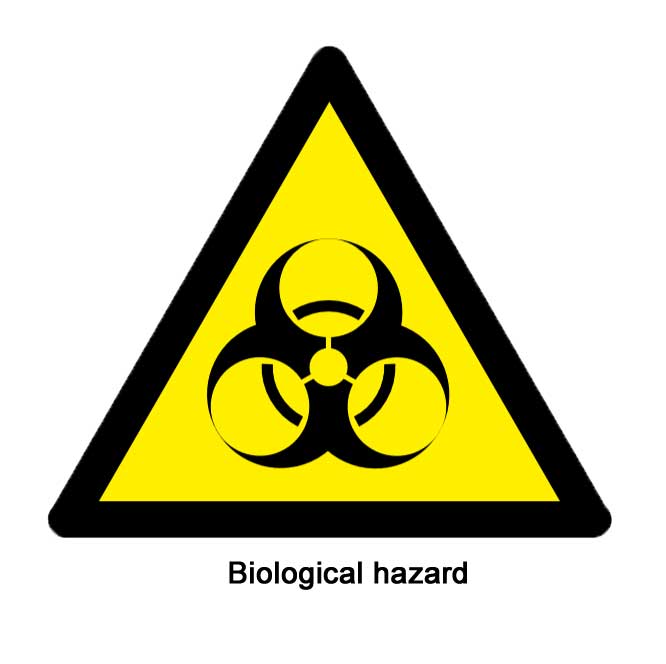 How
to request a COVID test
How
to request a COVID test Please
consider helping others by downloading the COVID Symptom Study app onto your
smart phone or Ipad and reporting how you feel either daily, or as you are
able. Note that currently there is no desktop PC version for Windows.
Please
consider helping others by downloading the COVID Symptom Study app onto your
smart phone or Ipad and reporting how you feel either daily, or as you are
able. Note that currently there is no desktop PC version for Windows.